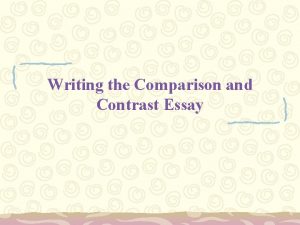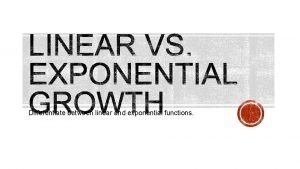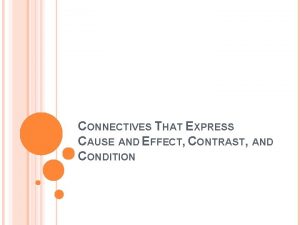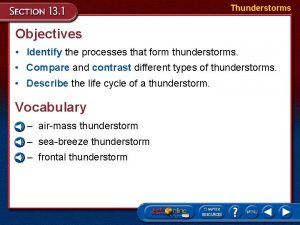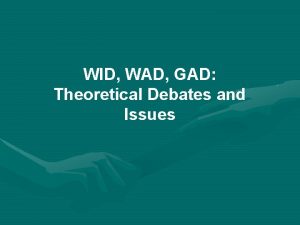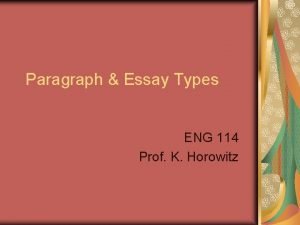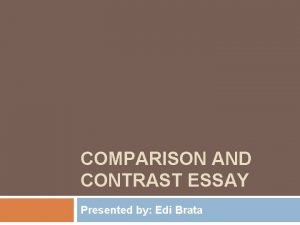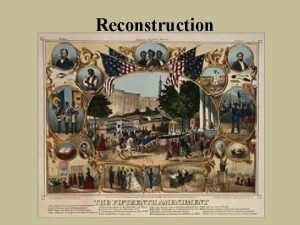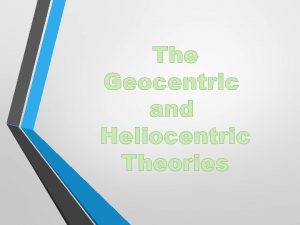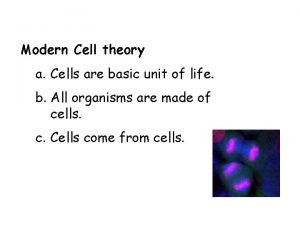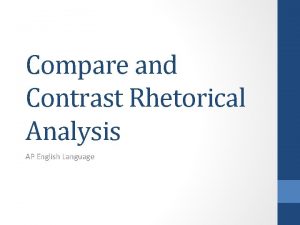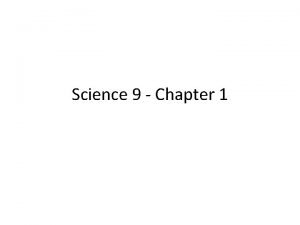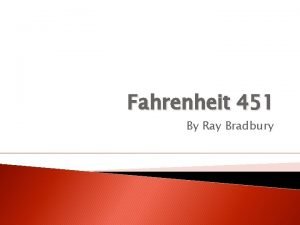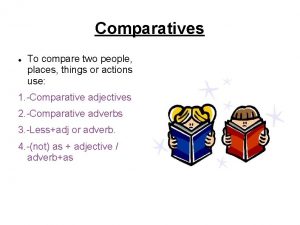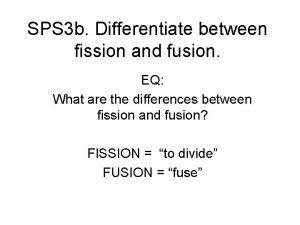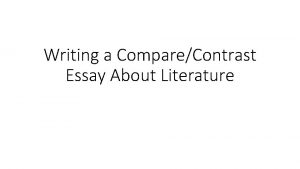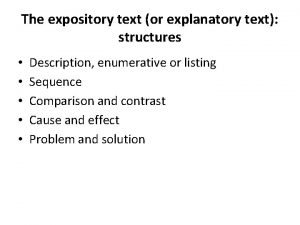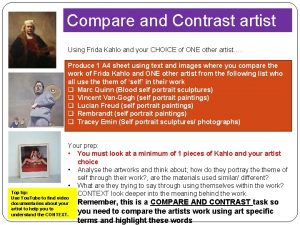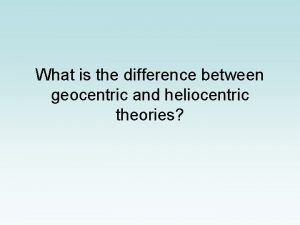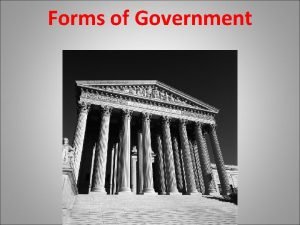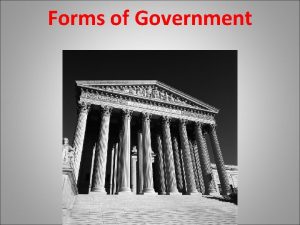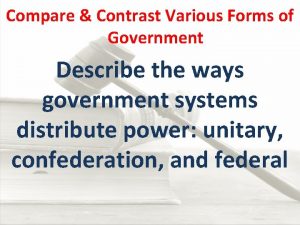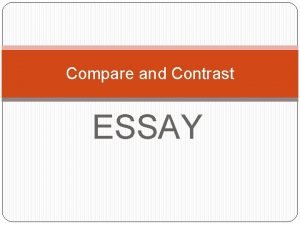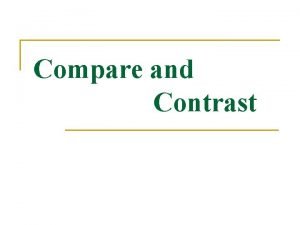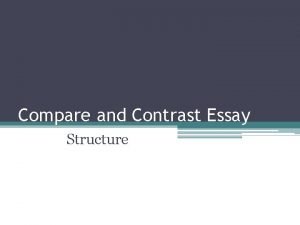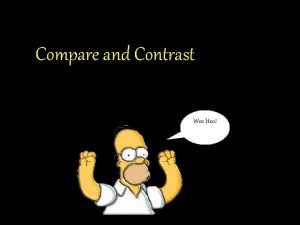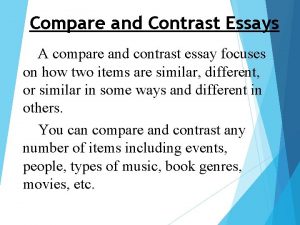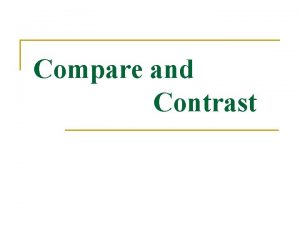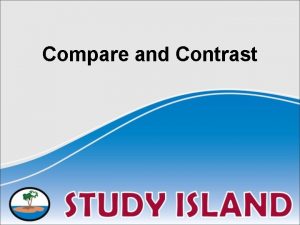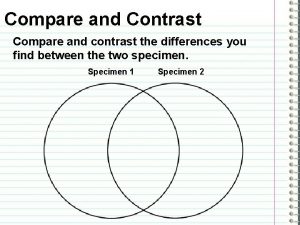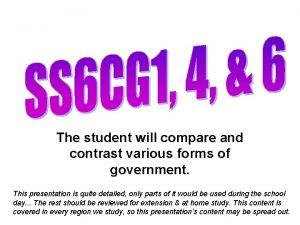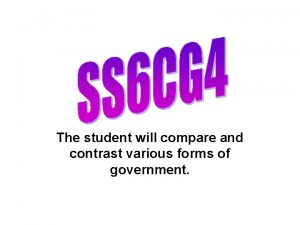Forms of Government Compare Contrast Various Forms of







































- Slides: 39

Forms of Government

Compare & Contrast Various Forms of Government Describe the ways government systems distribute power: 1. Unitary 2. Confederation 3. Federal

Ways Government Distributes Power All key powers are held by the central government Unitary Strong central government State/regional authorities hold most of the power Federal Confederation Weaker central government

Ways Government Distributes Power: Federal (Federation) Power is divided between one central and several regional authorities.

Federation / Federal Ways Government Distributes Power Regional Authority Central Authority Regional Authority

These Countries have Federal Governments: Argentina Australia Austria Belgium Brazil Canada Germany India Mexico Russia South Africa Spain Switzerland United Arab Emirates U. S. A. Venezuela Can you find 3 others?

Ways Government Distributes Power: Unitary Power is held by one central authority.

Unitary Ways Government Distributes Power Regional Authority Central Authority Regional Authority

List of Unitary States Afghanistan Albania Abkhazia Algeria Angola Armenia Azerbaijan Bangladesh Belarus Belize Benin Bhutan Bolivia Botswana Brunei Bulgaria Burkina Faso Burundi Cambodia Cameroon Cape Verde Central African Republic Chad Chile People's Republic of China Colombia Congo (Brazzaville) Congo (Kinshasa) Costa Rica Côte d'Ivoire Croatia Cuba Cyprus Czech Republic Denmark Djibouti Dominican Republic East Timor Ecuador Egypt El Salvador Equatorial Guinea

List of Unitary States Eritrea Estonia Fiji Finland France Gabon The Gambia Georgia Ghana Greece Grenada Guatemala Guinea-Bissau Guyana Haiti Honduras Hungary Iceland Indonesia Iran Ireland Israel Italy Jamaica Japan Jordan Kazakhstan Kenya Kiribati Kuwait Kyrgyzstan Laos Latvia Lebanon Lesotho Liberia Libya Liechtenstein Lithuania Luxembourg Macedonia Madagascar Malawi Maldives

List of Unitary States Mali Malta Marshall Islands Mauritania Mauritius Moldova Monaco Mongolia Montenegro Morocco Mozambique Myanmar Namibia Nauru Netherlands New Zealand Nicaragua Niger North Korea Norway Oman Palau Panama Papua New Guinea Paraguay Peru Philippines Poland Portugal Qatar Romania Rwanda Saint Lucia Saint Vincent and the Grenadines Samoa San Marino São Tomé and Príncipe Saudi Arabia Senegal Serbia Seychelles Sierra Leone Singapore Slovakia

List of Unitary States Slovenia Solomon Islands South Africa South Korea Spain Sri Lanka Suriname Swaziland Sweden Syria Republic of China (Taiwan) Tajikistan Tanzania Thailand Togo Tonga Zambia Trinidad and Tobago Zimbabwe Tunisia Turkey Turkmenistan Tuvalu Uganda Ukraine United Kingdom Uruguay Uzbekistan Vanuatu Vatican City Vietnam Yemen

Confederation Ways Government Distributes Power: • Voluntary association of independent states that often only delegate a few powers to the central authority. • Secure some common purpose. • Agree to certain limitations on their freedom of action. • States retain considerable independence. • Less binding than a federation.

Confederation Ways Government Distributes Power Regional Authority Central Authority Regional Authority

List of Confederations today Iroquois Confederacy (1090–present) European Union and OPEC Historic confederations New England Confederation (1643– 1684) United States of America under the Articles of Confederation (1781– 1789) Confederate States of America, (1861– 1865)

Compare & Contrast Various Forms of Government How governments determine citizen participation: 1. Autocratic 2. Oligarchic 3. Democratic.

Autocratic Oligarchic Citizen Participation Government Power General Citizens’ Participation Select Citizens’ Participation Government Power Citizen Participation Government Power How Governments Determine Citizen Participation Democracy

How Governments Determine Citizen Participation: Autocratic One person possesses unlimited power. The citizen has limited, if any, role in government.

How Governments Determine Citizen Participation: I. Autocratic • The oldest form of government. • Most common form of government in history. • Autocrats maintain power through inheritance or ruthless use of military and police power. • Rulers cannot be held accountable to the will of the people.

How Governments Determine Citizen Participation: Dictatorship Sudan and Cuba A form of government in which a ruler or small clique wield absolute power (not restricted by a constitution or laws).

How Governments Determine Citizen Participation Forms of Autocratic Governments: • Absolute or Totalitarian Dictatorship • Ideas of a single leader glorified. • Government tries to control all aspects of social and economic life. • People lack the power to limit their rulers. • Examples- Adolf Hitler, Benito Mussolini, Joseph Stalin

Forms of Autocratic Governments: Monarchy Government in which supreme power rests in the hands of a monarch who reigns over a state or territory, usually for life and by hereditary right. The monarch may be either the sole absolute ruler OR a sovereign such as a king, queen, or prince with constitutionally limited authority.

How Governments Determine Citizen Participation: Forms of Autocratic Govts. • Absolute Monarchy • King, queen, or emperor exercises the supreme powers of government/unlimited power. • Position is usually inherited. • People lack the power to limit their rulers. • Absolute monarchs are rare today, but from the 1400 s to the 1700 s they ruled most of Western Europe. • Examples- King of Saudi Arabia.

Constitutional Monarchy Japan and Canada A system of government in which a monarch is guided by a constitution whereby his/her rights, duties, and responsibilities are spelled out in written law or by custom.

How Governments Determine Citizen Participation: II. Oligarchy Government by the few. Usually a small group exercises control, especially for corrupt and selfish purposes. The citizen has a very limited role.

How Governments Determine Citizen Participation: Oligarchy The group gets its power from 1. military/political might (One-Party System) 2. social power (Aristocracy) 3. wealth (Plutocracy) 4. religion (Theocracy) 5. Some combination of the above *Communist China is an example of a One-Party System; Iran is an example of a Theocracy

Communist China A system of government in which the state plans and controls the economy (command economy) and a single party-often authoritarian- holds power. State controls are imposed with the elimination of private ownership of property while claiming to make progress toward a higher social order in which all goods are equally shared by the people (i. e. , a classless society).

Theocracy Iran A form of government in which a Deity is recognized as the supreme civil ruler, but the Deity's laws are interpreted by ecclesiastical authorities (bishops, mullahs, etc. ); a government subject to religious authority.

How Governments Determine Citizen Participation: Autocracy & Oligarchy • Sometimes claim they rule for the people. • In reality, the people have very little say in both types of government. • Examples: May hold elections with only one candidate or control the results in various ways. • Examples: Even when these governments have a legislature or national assembly, they often only approve decisions made by the leaders.

III. Democracy: Two Types A. Direct (pure): rule by the people themselves. B. Indirect (representative): rule by elected representatives. Founders' distrust of direct democracy: 1. Impracticalities. 2. Fleeting passions of the people.

Republic A representative democracy in which the people's elected deputies (representatives), not the people themselves, vote on legislation.

Sample Test Question What is a basic way citizens of a democratic nation can influence the government? A. voting B. working C. obeying laws D. consuming goods

Sample Test Question What is a basic way citizens of a democratic nation can influence the government? A. voting* B. working C. obeying laws D. consuming goods

Compare & Contrast Various Forms of Government Describe the two predominant forms of democratic governments: Parliamentary & Presidential

Describe the two predominant forms of democratic government: parliamentary and presidential Presidential Democracy A system of government in which the president is constitutionally independent of the legislature. The executive branch exists separately from the legislature (to which it is generally not accountable).

Describe the two predominant forms of democratic government: parliamentary and presidential Parliamentary Democracy A system of government in which executive and legislative functions both reside in an elected assembly called parliament. Typically has a Prime Minister, Premier, or Chancellor elected by the legislature from that body according to party strength. Examples: Israel, Canada, Australia, Japan


Parliament in London

Parliamentary United Kingdom Government in which members of the cabinet and its prime minister (executive) are nominated to their positions by a legislature (parliament), and are directly responsible to it. This type of government can be dissolved at will by the parliament (legislature) by means of a “no confidence” vote, or the leader of the cabinet may dissolve the parliament if it can no longer function. (Also Constitutional Monarchy)
 Double contrast vs single contrast
Double contrast vs single contrast Alternating method compare and contrast
Alternating method compare and contrast What is the difference between linear and exponential
What is the difference between linear and exponential Signing naturally unit 4:7 answer key
Signing naturally unit 4:7 answer key Point-by-point arrangement
Point-by-point arrangement Connectives of contrast
Connectives of contrast Compare and contrast cold wave and wind chill factor
Compare and contrast cold wave and wind chill factor Wearing down with water
Wearing down with water Draco malfoy poem
Draco malfoy poem Compare and contrast carbon and nitrogen cycles
Compare and contrast carbon and nitrogen cycles Compare and contrast spring tides and neap tides.
Compare and contrast spring tides and neap tides. What is wid, wad and gad
What is wid, wad and gad Compare and contrast mechanical and chemical weathering
Compare and contrast mechanical and chemical weathering A two word poetic renaming
A two word poetic renaming Example of compare and contrast paragraph
Example of compare and contrast paragraph Compare and contrast tornadoes and hurricanes
Compare and contrast tornadoes and hurricanes Because of winn-dixie book and movie comparison
Because of winn-dixie book and movie comparison Edi brata
Edi brata Compare and contrast trustee period and royal colony
Compare and contrast trustee period and royal colony Compare and contrast sharecropping and tenant farming
Compare and contrast sharecropping and tenant farming Transition words for compare and contrast
Transition words for compare and contrast Geocentric and heliocentric compare and contrast
Geocentric and heliocentric compare and contrast Guac wheel
Guac wheel Compare and contrast rhetorical analysis essay example
Compare and contrast rhetorical analysis essay example Parthenogenesis asexual reproduction
Parthenogenesis asexual reproduction Country life vs city life compare /contrast
Country life vs city life compare /contrast Paradoxes in fahrenheit 451
Paradoxes in fahrenheit 451 Banquo key quotes act 1
Banquo key quotes act 1 Floral shops bookstores and farms are examples of
Floral shops bookstores and farms are examples of Quickly comparative
Quickly comparative West asian israel arabia musical instruments
West asian israel arabia musical instruments Compare and contrast fission and fusion.
Compare and contrast fission and fusion. Compare and contrast banana and orange
Compare and contrast banana and orange Compare and contrast transverse and longitudinal waves
Compare and contrast transverse and longitudinal waves Point-by-point essay examples
Point-by-point essay examples Number and stats signpost
Number and stats signpost Narrative vs expository text
Narrative vs expository text How to identify bases
How to identify bases Compare and contrast frida kahlo and diego rivera
Compare and contrast frida kahlo and diego rivera Geocentric theory meaning
Geocentric theory meaning

